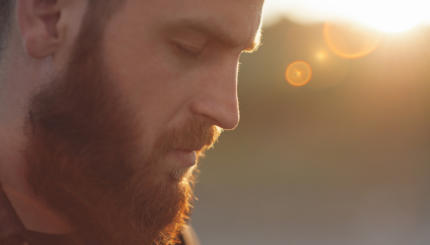Reprinted with permission from Pray Tell: A Hadassah Guide to Jewish Prayer, published by Jewish Lights.
Why did the ancient sages change the b’rakhah [blessing] formula? Why did they alter the Bible’s typical declaration about God to develop the b’rakhah, in which a person speaks directly to God? Professor [Joseph] Heinemann [a 20th-century German-Israeli scholar of liturgy] answers:
Undoubtedly this gives expression to the inclination to give prayer, even fixed prayer, the quality of turning directly to God as in a conversation in which is revealed the intimate and personal relationship between the one who prays and his God.” (See Heinemann’s book, Prayer in the Talmud: Forms and Patterns, published by Walter De Gruyter, 1977.)
With the addition of the word “You” (Attah), the predominant biblical formula (“Blessed is the Lord”) changes to direct confrontation with God (“Blessed are You, Lord”).
The change became a fixed part of Jewish liturgy over the course of time, and involved much discussion and argument.

Help us keep Jewish knowledge accessible to millions of people around the world.
Your donation to My Jewish Learning fuels endless journeys of Jewish discovery. With your help, My Jewish Learning can continue to provide nonstop opportunities for learning, connection and growth.
A Personal Relationship with God
The recounts that two sages of the third century, Rav and Shmuel, debated the addition of the word “You” to the b’rakhah formula (Jerusalem Talmud, B’rakhot12:4). Rav insisted that a b’rakhah include “You,” as he maintained that we turn directly to God in a b’rakhah. Rav cites Psalms 16:8 as support: “I have set the Lord before me always” (Jerusalem Talmud, B’rakhot 9:1). Rav’s doctrine is theologically bold, and reflects the desire for a personal relationship with God. Mere creatures can address their Creator directly. Shmuel, however, maintained that a b’rakhah need not include Attah; when it does, it places mere mortals in too intimate a relationship with the Creator of the universe.
Apparently, before their debate, Jews used several different formulas for b’rakhot. All Jews have a religious obligation to utter a b’rakhah at the appropriate time, but what words should we use? If expressing gratitude is the main idea, perhaps the specific words do not matter. We learn, though, from the debate between Rav and Shmuel, that the words are important indeed.
The sages agreed on the need to establish a norm, a legal standard to which all must adhere, but they initially differed about the wording of that norm. Ultimately, Jewish law followed Rav’s opinion. Thus, if we do not include the word Attah or “You,” we do not fulfill our obligation to recite a b’rakhah. A person who recites words that differ from the established norm may have uttered something admirable, but has not fulfilled his or her religious obligation.
God in the Third-Person Remains
The opinion of Shmuel also found its way into the b’rakhah formula. (Decisions in Jewish legal tradition often reflect both sides to a debate.) The last part of the obligatory wording of the b’rakhah, following the mention of God as King of the universe, refers to God in the third person, thereby following the Bible’s pattern.
To consistently conform to Rav’s opinion, we would state the entire b’rakhah in the second person. For example, “Blessed are You, Lord our God, King of the universe, for You bringforth bread from the earth. Instead, the b’rakhah as we know it is grammatically confusing. It switches from addressing God in the second person (“You”) to referring to God in the third person (“who brings forth”).
In the Presence of Royalty
Scholars have discussed the inconsistent grammar of the b’rakhah for centuries. Simhah ben Samuel, author of the 11th-century French Mahzor Vitry, compares the wording of the b’rakhah to the wording one uses in the presence of royalty. First we speak directly to the King (in the second person, as in “Your Majesty”). Later we use language that shows even more respect, maintaining distance, speaking as through an intermediary (in the third person, as in “His Majesty”). The author of Mahzor Vitry chooses the b’rakhah recited before drinking wine to illustrate:
We say, ‘Blessed are You, Lord our God, King of the universe who creates (borei–third person) the fruit of the vine.’…We do not say, ‘Blessed are You, Lord, who have created (shebarata–second person) the fruit of the vine.’ Thus, after we have addressed God directly (‘Blessed are You’) we must relate to Him as if through an intermediary (‘who creates’).
Both Revealed and Concealed
We find another explanation of the grammatical peculiarity of the b’rakhah in the writings of the 14th-century Spanish authority, Abudraham. He taught that the blessing’s structure teaches us about the nature of God, who is both revealed to and concealed from mortals. God is revealed in His deeds and God is concealed in the mystery of His divinity, which is difficult or impossible for a mortal to grasp. The b’rakhah formula reflects the nature of human beings as well:
Mortals are a combination of body and soul. From the perspective of the human soul, it is appropriate for a person to cleave to his Maker, always standing before Him. From the perspective of the human body, however, a mortal cannot stand before God. Therefore the b’rakhah, uttered by mortals, uses language that is both direct [in the second person] and concealed [in the third person].
Dr. Max Kadushin, a 20th-century scholar, considered such explanations inadequate. He wrote: “The attempt to make an idea specific when the rabbis [of the Talmud] have not done so often results in the misinterpretation of a rabbinic idea.” Kadushin notes that the rabbis in the Talmud did not explain the change from second person to third person either rationally or philosophically, because they did not have a rational or a philosophical apprehension of God.
A Relationship like No Other
They had, according to Kadushin, a mystical apprehension of God. When the medieval authorities discuss the b’rakhah, they understand the use of the second person and the third person as two separate ways of relating to God. Thus, they need to account for the change from second person to third person by associating each with a different idea.
adushin maintains, however, that the b’rakhah deals with what can only be described as a mystical consciousness, the consciousness of a relationship like no other, that is, the relationship of Creator and creature, immortal God and mortal human beings. The mystical consciousness is expressible to a point, but in a manner in which no other relationship is expressible.
The b’rakhah formula thus enables the Rabbis and the people as a whole to express their consciousness of relationship to God… It was nothing short of religious genius first to have achieved the b’rakhah formula and then to have made it the basic element of the prayers.” (Kadushin, The Rabbinic Mind, published by the Jewish Theological Seminary of America)


